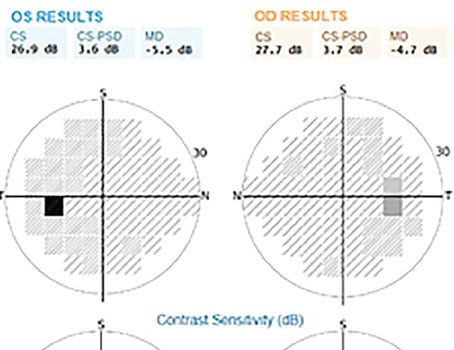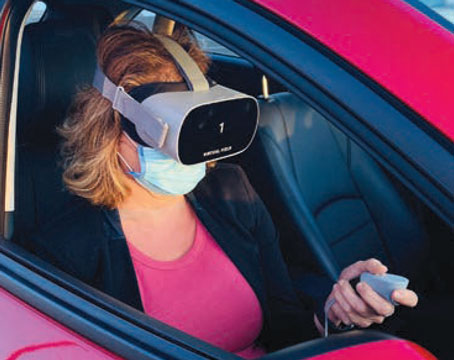As new alternatives for glaucoma surgery have begun to proliferate, two questions have become increasingly relevant for glaucoma surgeons: Which of these options make the most sense for which patients? And, which new procedures, if any, should I add to my surgical repertoire? Here, five surgeons share their thoughts on when and whether to use the best-known glaucoma surgery options, including trabeculectomy, tube shunts, the ExPress shunt, deep sclerectomy, canaloplasty and the Trabectome.
Trabs and Tubes
Trabeculectomy, still considered the gold standard in glaucoma surgery (commonly performed today with an antimetabolite such as mitomycin-C), remains the most commonly performed glaucoma surgery, with a high success rate in most groups and glaucoma diagnoses, especially in the hands of an experienced surgeon. However, its popularity has been steadily declining as newer options have appeared.
Perhaps the most common alternative surgical choice at present is the implantation of a tube shunt—most often an Ahmed or Baerveldt device. These alternatives can be particularly helpful when dealing with diagnostic categories such as neovascular glaucoma, uveitic glaucoma, iridocorneal endothelial syndrome, fibrous ingrowth, epithelial downgrowth or patients who have had previous vitreoretinal surgery or penetrating keratoplasty, where the success rate for trabeculectomy is far lower. Tube shunts have also become popular for use in younger patients whose more vigorous healing response can undermine the success of trabeculectomy.
The desire to leave future options open can also be a factor when choosing between trabeculectomy and tube shunts. "For a patient with good conjunctiva, a trabeculectomy makes sense because the success rate is high and it leaves more options open," notes Jonathan S. Myers, MD, assistant attending surgeon at the Wills Eye Institute in
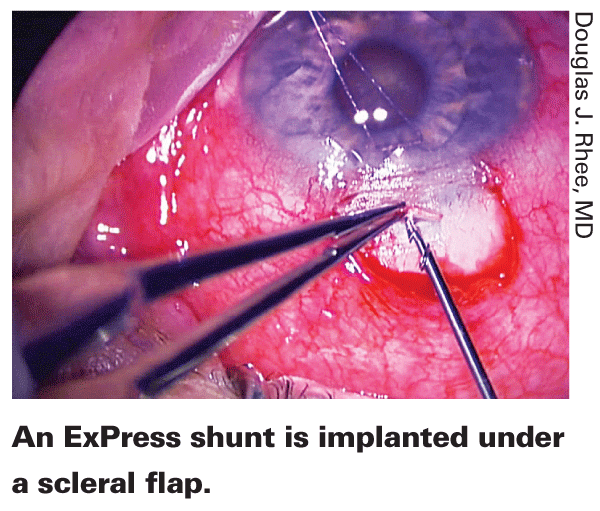
However, Dr. Myers agrees that tube shunts are excellent for patients who have types of glaucoma that put them at high risk of failure with trabeculectomy. "The Tube vs. Trab study data suggest that tube shunts can be very effective in situations where the success rate of trabeculectomy is more limited," he notes. "That includes patients with prior intraocular surgery or prior failed trabeculectomy." Nevertheless, Dr. Myers says he'd choose a trabeculectomy over a tube shunt for most patients.
Arthur J. Sit, MD, assistant professor of ophthalmology at the Mayo Clinic College of Medicine in
"The height of the buckle also matters," he continues. "If it's significantly elevated above the surface of the sclera, then it's difficult to put in a tube; but it's possible to put in a Schocket tube, where you place the tube into the capsule around the buckle. If it's a low buckle, it's possible to put a drainage tube right over top of it. I've tried the
Trabectome with a very small number of scleral buckle patients, but it doesn't seem to be very effective in those patients, so it wouldn't be my first choice when the eye has a scleral buckle."
Tubes as Primary Surgery?
Some surgeons have proposed using tube shunts regularly as a primary surgical option.
"I know that some surgeons believe tube shunts might be a good primary surgery," says Douglas J. Rhee, MD, assistant professor at
"I generally consider tubes as a primary procedure if the patient has extensive conjunctival involvement with a scleral buckle or trauma, where a trabeculectomy has very little chance of working, or in cases of neovascular glaucoma," he adds. "I still do trabeculectomy in uveitic patients, although the type of uveitis makes a difference. Of course, tubes are very good in children. For me, that would be the main indication for tubes as a primary choice."
Using the ExPress Shunt
Most surgeons consider using the ExPress Glaucoma Shunt (
"I know that some surgeons use the ExPress in every trabeculectomy, although I'm not one of them," he continues. "Peter Netland's recent paper1 showed that using the ExPress does seem to ward off some hypotony in the early postop stages, and there are many theoretical advantages to using it—a more stable anterior chamber; a more standard-sized transscleral pathway (i.e. hole); and a more standardized procedure. However, there's no evidence that any of that results in a better long-term outcome."
"The ExPress shunt does standardize one small aspect of trabeculectomy, and it does make the surgeon's life a bit easier," observes Dr. Myers. "However, it's an expensive device, so I'm waiting for evidenced-based medicine to show me that its advantages make it worth the cost. Several studies are under way that might answer those questions."
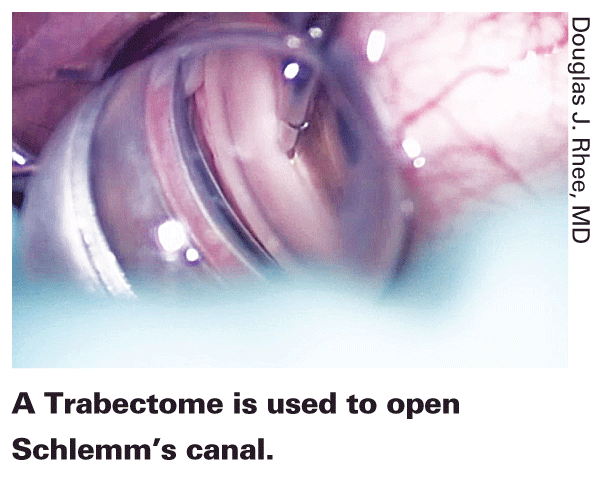
Deep Sclerectomy
Although this form of non-penetrating surgery is often used in Europe, it hasn't become very popular in the
Dr. Myers says he has sometimes opted for using deep sclerectomy. "In my experience, patients who have high pressures to begin with and fairly healthy optic nerves often don't need low target pressures, but do have a risk of complications from shallow anterior chambers. These are potentially good candidates for nonpenetrating surgery," he explains. "Like canaloplasty, which I haven't adopted, deep sclerectomy has a reduced risk of shallow chambers. In contrast, after trabeculectomy, a patient like this can be at risk for a shallow chamber, choroidal detachment and aqueous misdirection. Minimizing those risks is very appealing."
Newer Options
Most of these surgeons perform one or more of the recent entries in the surgical sweepstakes, such as the Trabectome and canaloplasty. Although the newer surgeries appear to have lower long-term risk than trabeculectomy, surgeons agree that a major limitation of the newer options is their inability (in most cases) to lower IOP into the low teens or single digits. However, given that patients have different starting pressures, levels of damage and desired pressure endpoints, it seems clear that many patients can still benefit from the advantages of these procedures.
Along those lines, Dr. Sit, who offers his patients most of these surgeries, says that the main factor influencing his choice of glaucoma surgery is target IOP. "My decision regarding target IOP is based on multiple factors," he notes. "Those include the starting pressure, the degree of optic nerve damage, the degree of visual field loss and other considerations. If the pressure I want to achieve is in the low teens or single digits, there really isn't any surgery available right now other than trabeculectomy that will achieve that consistently. But if a given patient is able to tolerate a higher pressure, the other surgeries become reasonable. At that point it's a matter of looking at specific anatomical restrictions that may exist.
"For example," he continues, "if a patient has closed-angle glaucoma, then angle surgeries like the Trabectome or the iStent aren't going to be feasible; I'd still do a trabeculectomy. If the patient can tolerate a higher pressure and has an open angle, I probably would try a Trabectome, or an iStent once it's available, or perhaps a canaloplasty or a gold shunt. They provide a much faster recovery and they're safer. If they don't work, with the possible exception of canaloplasty, your options for performing trabeculectomy later on have not been impacted at all."
Dr. Rhee notes that it's important to remember that although these procedures seem to be safer than trabeculectomy, that's not the same as being completely safe. "Both canaloplasty and Trabectome can have complications," he points out. "This is still surgery; it's just that your chances of hurting the patient are less. No procedure is totally benign."
Using the Trabectome
Donald Budenz, MD, MPH, associate professor in the departments of ophthalmology, epidemiology and public health at the University of Miami Miller School of Medicine, and associate medical director at the Bascom Palmer Eye Institute in
"In selected patients, such as those who don't need a very low pressure and those who are starting with higher pressures, such as patients with POAG or exfoliative or pigmentary glaucoma, this is the sort of procedure I would use first," he says. "That makes sense to me because if it doesn't work, you haven't scarred the conjunctiva. As a result, a trabeculectomy done later should have the same success rate as a primary trabeculectomy would have. As long as the damage to the visual field and optic nerve isn't severe, I'd be happy with the pressures these ab interno procedures produce."
Dr. Budenz admits that Trabectome has a lower success rate than trabeculectomy, but sees that as a trade-off. "Since the risks with Trabectome are low and you don't scar the conjunctiva, it's reasonable to consider that option after you've tried drops and laser, before you go on to trabeculectomy. If the patient falls within the 30 percent or more of patients who don't get a pressure reduction with Trabectome, you can always do a trabeculectomy afterwards."
"I think the predominant role for Trabectome is in association with cataract surgery," says Dr. Rhee. "It helps to decrease the rate of IOP spikes postoperatively, although it doesn't eliminate them. The ideal scenario seems to be when you have an older patient with moderate to advanced open-angle glaucoma whose IOP is well controlled, but requires three or four medications. Adding the Trabectome procedure to cataract removal seems to blunt postoperative IOP spikes, much as trabeculectomy does." Dr. Rhee adds that in his experience, Trabectome doesn't seem to be as effective in younger patients, although the reason isn't yet clear.
Canaloplasty
Glaucoma specialist Howard Barnebey, MD, medical director and CEO of Specialty Eyecare Centres in
Dr. Barnebey notes that the differences between canaloplasty and trabeculectomy have parallels in other areas of medicine. "You can liken a canaloplasty in ophthalmology to an angioplasty in cardiovascular terms," he says. "If someone has significant cardiovascular disease and symptoms of angina or heart attack, often the first step is to place a stent, which is a way of trying to recreate normal physiologic flow through the passageway. However, if there's diffuse, significant disease, that's not an option, and you have to crack the chest and resort to coronary bypass surgery. When we cannulate Schlemm's canal, we're also trying to recreate normal physiologic flow. And as in cardiovascular disease, if that doesn't work, we do a bypass, which might be a trabeculectomy or a glaucoma drainage device." Dr. Barnebey notes that this model helps his patients to understand the difference between the two procedures.
Dr. Barnebey admits that even when a surgeon is proficient at canaloplasty, it does take a little longer than trabeculectomy. "A trabeculectomy takes me 25 to 30 minutes, whereas this takes me 40 to 45 minutes," he says. "But I think the extra 10 or 15 minutes is worth it to avoid ending up with a bleb. You make up the time in reduced postoperative follow-up. Canaloplasty postop visits tend to be much more predictable than those following trabeculectomy. Furthermore, because canaloplasty doesn't depend on creating a bleb, age appears to be less of a barrier than it is with trabeculectomy."
Would canaloplasty make sense as a primary option? "Over the past three years, canaloplasty has emerged as my go-to procedure," says Dr. Barnebey. "I might choose it even if trabeculectomy was feasible. Based on the data I've seen, other people get the pressure down to about 15 mmHg at three years, and I often get final pressures between 12 and 13 mmHg on no meds at one year out. I think that's very comparable to trabeculectomy."
Finding the Ideal Candidate
Dr. Barnebey says that surgeons often say they'd like to start performing canaloplasty, but they're looking for an "ideal" patient. "Patients who are good candidates," he says, "are those with open-angle glaucoma, including pigmentary dispersion and pseudoexfoliation. On the other hand, people with narrow angles, or angles with scar tissue or significant abnormalities such as angle recession, would not be good candidates—even though the angle may appear to be open. Neovascular glaucoma also would not be a good choice." Dr. Barnebey adds that a patient who has had a trabeculectomy in the eye in question may be a poor candidate. "I've done canaloplasty in these patients a number of times with moderate success," he notes, "but as a rule it's not the best choice in that situation."
Dr. Barnebey says his experience has led him to see three categories of patients as particularly good candidates. "The first group is patients in whom I expect a trabeculectomy to fail, such as patients who've already had a failed trabeculectomy in the fellow eye, and those who have significant ocular surface disease, or chronic low-grade inflammation," he says. "That might even include dry eye that's unresponsive to medical treatment, or eyes with significant scarring of the conjunctiva.
"The second group of good candidates is those in whom a trabeculectomy or tube shunt would create a high risk of additional vision loss," he continues. "For example, a young male with high myopia is more likely to have hypotony and could end up with further loss of vision. If a patient has had a trabeculectomy in the other eye and experienced hypotony after that surgery, I'd avoid doing a trabeculectomy. I'd also avoid trabeculectomies and tube shunts in patients with advanced damage where the visual field has split fixation or they have loss in both hemifields; patients who are immunosuppressed, where I'd be concerned about their ability to heal; patients who are diabetic with early retinopathy or diabetic macular edema; and patients who are taking a lot of anticoagulants. I'd consider canaloplasty for any of these patients.
"The third group comprises those who can't tolerate postop blurred vision," he adds. "For the most part, when we do a trabeculectomy, most of us appreciate that there's going to be a prolonged postop period in which vision is blurry—between three and six weeks; sometimes much longer. With canaloplasty, postop healing is very quick. Often these patients are better in a week, or a week and a half. So the period of blurred vision, incapacity, concern for limiting their physical activity and things like that, is not as prolonged as with a trabeculectomy."
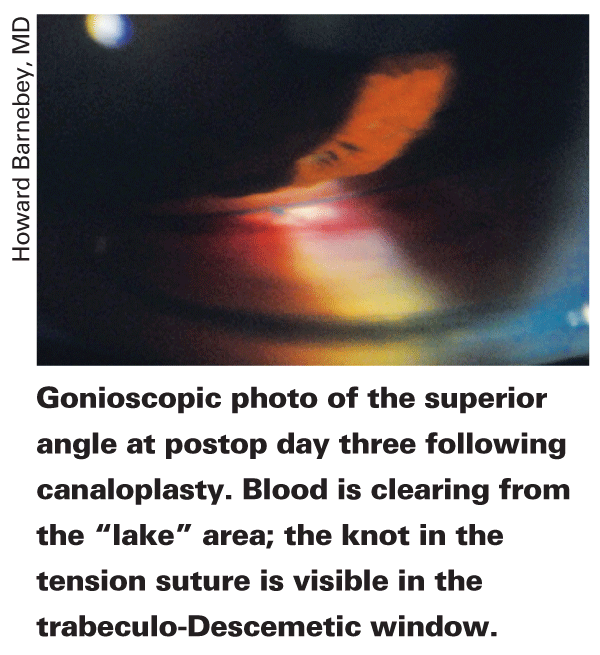
Trabectome or Canaloplasty?
Given some similarities between Trabectome and canaloplasty, what might cause a surgeon to choose one over the other for a given patient? "The two are mutually exclusive," notes Dr. Rhee. "Once you do either canaloplasty or Trabectome, you can't do the other.
"In my experience, canaloplasty is a little more effective at lowering IOP than the Trabectome, but there are two strikes against it," he continues. "First, you have to use a quadrant of conjunctiva, so a later trabeculectomy will be at a disadvantage because of scarring. It may be possible to convert the canaloplasty into a trabeculectomy at a later date, but once an area of conjunctiva has been affected by any kind of surgery, whether corneal, retinal, glaucoma or even extracap cataract surgery, subsequent success rates of trabeculectomy are lower. My second concern is that canaloplasty is technically rather challenging. It's not an easy procedure."
Dr. Barnebey doesn't see a canaloplasty as reducing future surgical options; he says that the conjunctival wound healing response for a canaloplasty is not as pronounced as the one observed after a failed trabeculectomy. "The majority of patients will have scarring limited to the original limbal incisional area," he says. "This is similar to a patient who previously underwent cataract surgery with a scleral incision in the superior quadrant." Dr. Barnebey also disagrees with the notion that canaloplasty is too difficult to do. "Yes, it is a meticulous procedure," he says. "You have to perform a series of steps that most of us were not trained to do as residents or fellows. But when you learn to do a new procedure such as phaco, you don't expect a perfect result after five cases—more like 25 or 50 cases. With canaloplasty, a surgeon who is patient and has reasonable expectations can do a successful surgery within five or 10 cases."
Dr. Rhee says he often lets his patients choose the option they prefer. "When it's time to consider the first incisional procedure, I generally describe the risks and benefits of Trabectome, canaloplasty and trabeculectomy, as well as the effect of failure on the performance of a subsequent procedure," he says. "When there are unique aspects of a case that seem to confer an advantage of one procedure over the others, I share that with them. Patients have their own risk tolerances and make the choice that's most comfortable for them."
Other Factors When Choosing
Several additional factors also influence our surgeons' choice of glaucoma surgery:
• Aphakia. An aphakic patient can be a cause for concern because of the possibility of vitreous becoming involved in the drainage opening, whether the surgery is trabeculectomy or a tube shunt. "Aphakic patients are difficult because of the presence of vitreous," agrees Dr. Sit. "A nonpenetrating procedure where you don't enter the eye would be a reasonable option when you're worried about prolapse of vitreous."
Dr. Rhee says that if a patient is aphakic, he's less enthralled about doing a
trabeculectomy. "However, chances are that if the patient is aphakic, he'll probably have scarring that's going to make canaloplasty not such a great idea," he says. "Trabectome might be possible. Tube shunt is a good option—unless you have vitreous in the anterior chamber. If that's the case, you can do a vitrectomy either from an anterior or a posterior approach. If you feel a trabeculectomy is indicated and the patient is aphakic, this might be a good situation in which to use the ExPress shunt; the ExPress will give you a more stable chamber. However, I believe a tube shunt will have a better chance of success."
Dr. Myers says the surgery he would choose for an aphakic patient would depend on the reason for the aphakia. "Are you aphakic because you had a complicated retinal detachment that required removing the lens and you now have a scleral buckle?" he asks. "Or are you aphakic because you had your cataract removed and didn't have a lens implant 20 years ago, and you have no other eye problems? Some of the latter patients do okay with trabeculectomy, but generally tube shunts are my go-to choice for aphakic patients."
• Other ocular or systemic conditions. "If a patient has a lot of surface disease, I prefer tube shunts to trabeculectomy," notes Dr. Myers. "That's because of the impact of surface disease on trabeculectomy success rates, such as in ocular pemphigoid, and the possibility of infection, as in chronic severe blepharoconjunctivitis. If a patient is obese or has a very broad neck or uncontrolled hypertension, I might be concerned about a greater risk of positive pressure during surgery or suprachoroidal hemorrhage. Some of these patients might be better off with surgeries that make smaller holes in the eye, or don't enter the eye, such as canaloplasty or deep sclerectomy, or possibly a tube shunt with delayed opening."
"Generally, systemic conditions don't play a large role in my decision making," says Dr. Sit. "But if the patient had collagen vascular disease and was prone to conditions like scleral thinning, I'd be more hesitant to perform a scleral procedure. Those patients also tend to have more inflammation."
• Patient age. This primarily seems to be a factor in terms of how likely the patient is to live long enough to need further surgery. "The literature shows pretty clearly that all surgeries are likely to fail, on average within five years," says Dr. Sit. "So for someone who is relatively young, I'd try to start with a procedure that leaves me the most options going forward—one that's minimally invasive, causing the least disruption to the tissues of the eye. For me that would be an angle procedure like the Trabectome."
• Reimbursement concerns. Dr. Myers notes that on a larger scale reimbursement certainly can influence the profession's surgical choices. "If reimbursement is made difficult for the surgeon or surgery center," he says, "it can definitely delay the adoption of an otherwise promising new technique."
Dr. Rhee says that he doesn't have to worry about reimbursement in his particular practice situation, which is hospital-based, but he knows that economic issues can't be avoided. "I would never criticize someone for taking insurance reimbursement into consideration," he says. "The equipment costs for some of these procedures are very high, while the reimbursement may be very low. To continue to practice medicine you can't let yourself, the hospital or the surgery center go bankrupt; if you do, no one can get care."
Dr. Barnebey acknowledges that uncertain reimbursement can be a factor when surgeons consider adding canaloplasty to their armamentarium. "Most of the Centers for Medicare & Medicaid Services directors will cover it on a case-by-case basis," he notes. "Other insurance companies are getting better about it. But it's like anything else that's new; a surgeon has to feel comfortable about why he's offering it to the patient and why it's to the patient's advantage, even if insurance doesn't cover it. It's a bit like offering a premium IOL, where patients may be responsible for payment themselves.
"In our practice," he continues, "we make sure patients understand that we can't guarantee insurance coverage, but that we'll help them with appeals, should they be necessary. It's mostly an issue of the surgeon's fee, since our ASC will almost certainly be covered by insurance, so it's not as expensive as it might be. In any case, very few patients choose to go with a different option."
Are More Options Better?
"I know that many surgeons are cautious about the newer surgeries, and I think that's healthy and warranted," says Dr. Rhee. "I don't think every surgeon should run out there every time something new comes along and try it. Nevertheless, I think it behooves us to try to offer as many surgical options as possible, so we can provide each patient with the surgery that best matches his or her needs."
Dr. Rhee believes that the proliferation of new surgical options will eventually result in a move away from what he sees as a tendency to think of one procedure as "the" procedure for treating glaucoma. "Trabeculectomy is the gold standard," he says.
"However, I think there's been a 'Lord of the Rings' mentality: 'One procedure to rule them all,' as it were, with the other procedures seen as niche procedures.
"Certain surgeries are good in certain situations," he continues. "I don't think any one of them is good in every situation. Furthermore, every procedure has drawbacks, even tube shunts; no matter what type of tube shunt you use, somewhere between 6 and 9 percent of patients end up with double vision. The availability of the newer surgical alternatives allows us to be more flexible and choose the procedure or device that matches the individualized characteristics of the patient. I strongly believe that will be the new trend. It's a change that will occur slowly, but I think glaucoma surgeons should start moving towards being able to offer all of the surgical options."
Dr. Rhee has no financial interest in any companies or products related to glaucoma surgery. Dr. Sit is a consultant for Alcon, Allergan and Glaukos. Dr. Myers has previously received a research grant from Glaukos as an investigator in an iStent trial. Dr. Barnebey recently became a consultant to iScience Interventional, manufacturer of the catheter used in the canaloplasty procedure. Dr. Budenz has no financial interest in any technology mentioned.
1. Maris PJ Jr, Ishida K, Netland PA. Comparison of trabeculectomy with ExPRESS miniature glaucoma device implanted under scleral flap. J Glaucoma 2007;16:1:14-9.
2. Lewis RA, von Wolff K, Tetz M, Korber N, Kearney JR, Shingleton B, Samuelson TW. Canaloplasty: Circumferential viscodilation and tensioning of Schlemm's canal using a flexible microcatheter for the treatment of open-angle glaucoma in adults: Interim clinical study analysis. J Cataract Refract Surg 2007;33:7:1217-26.
3. Shingleton B, Tetz M, Korber N. Circumferential viscodilation and tensioning of Schlemm canal (canaloplasty) with temporal clear corneal phacoemulsification cataract surgery for open-angle glaucoma and visually significant cataract: One-year results. J Cataract Refract Surg 2008;34:3:433-40.
4. Lewis RA, von Wolff K, Tetz M, Koerber N, Kearney JR, Shingleton BJ, Samuelson TW. Canaloplasty: Circumferential viscodilation and tensioning of Schlemm canal using a flexible microcatheter for the treatment of open-angle glaucoma in adults: two-year interim clinical study results. J Cataract Refract Surg 2009;35:5:814-24.
